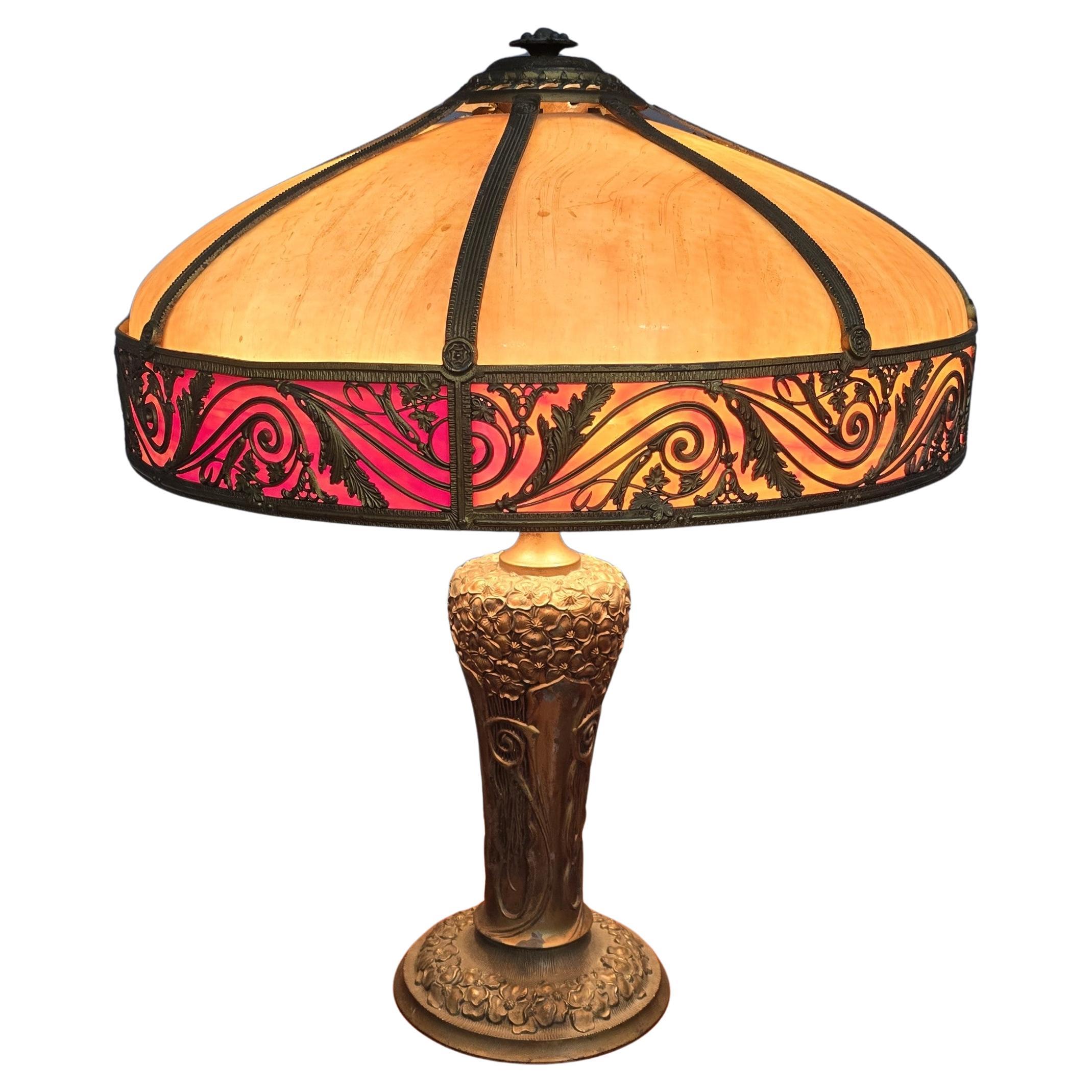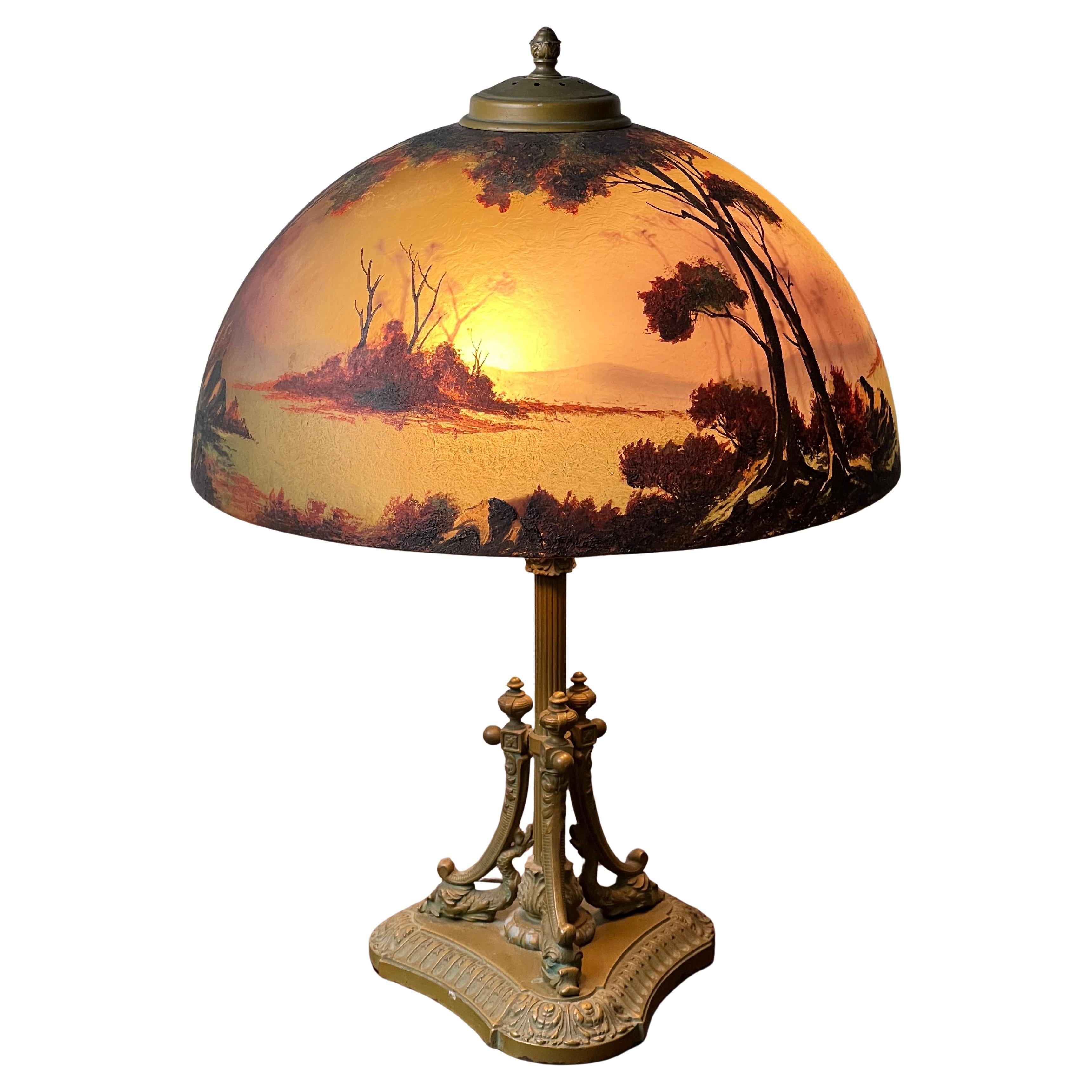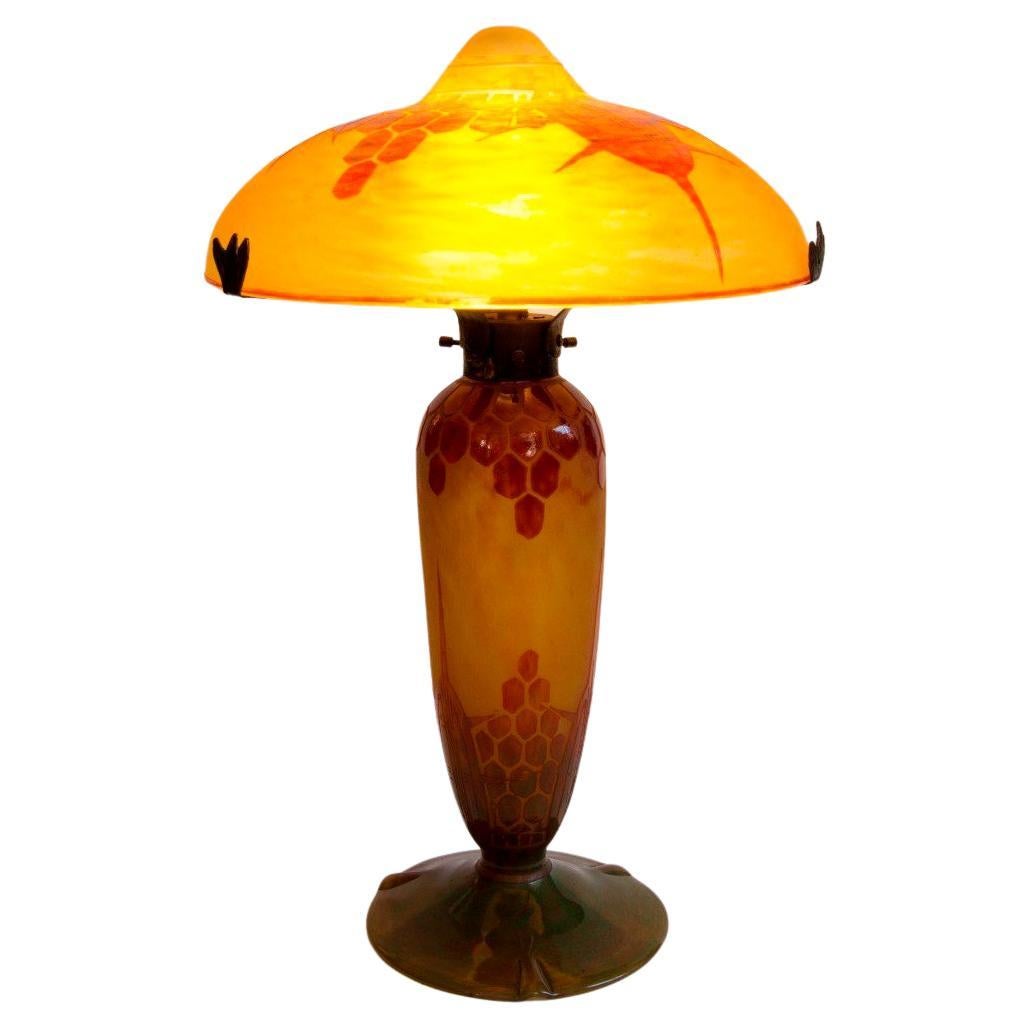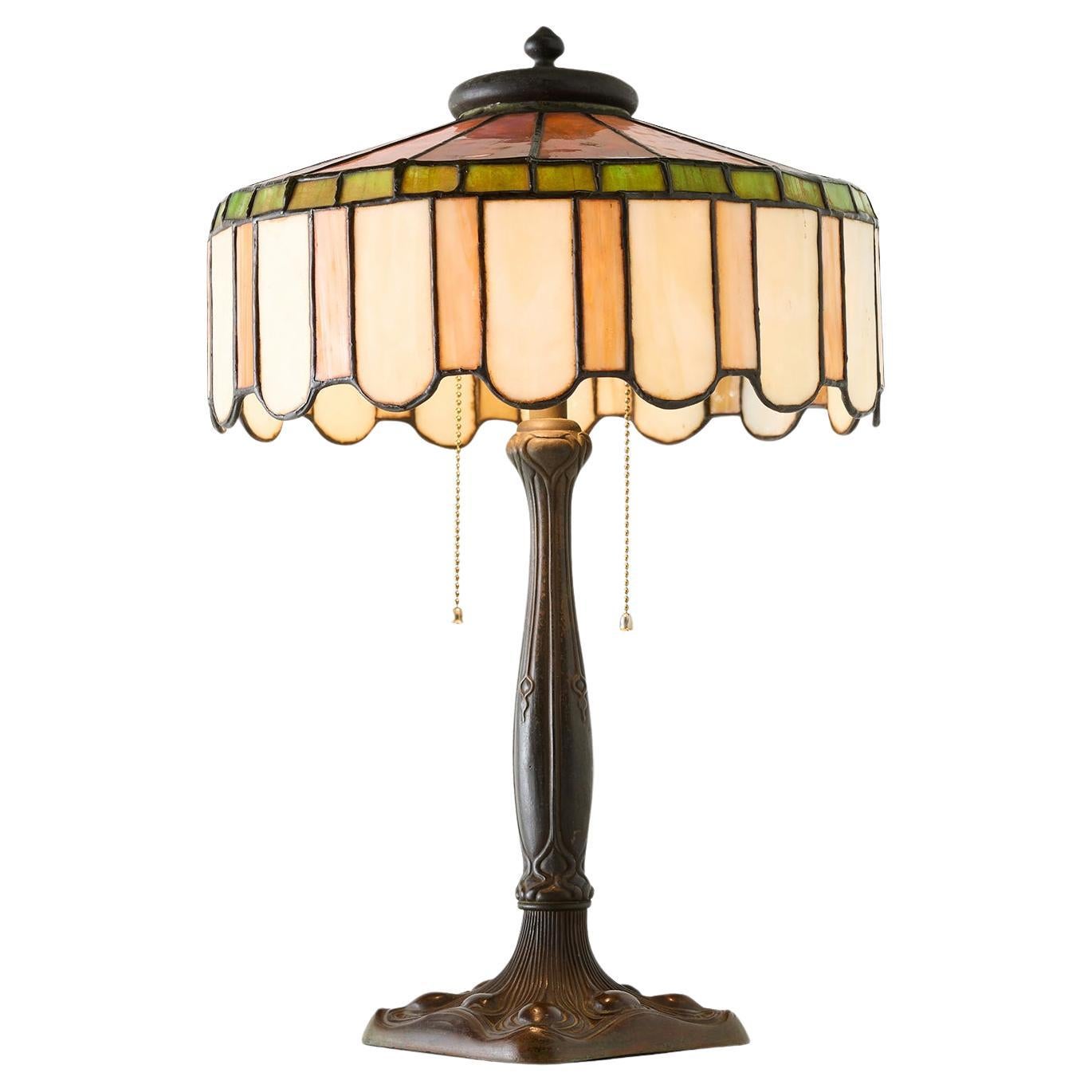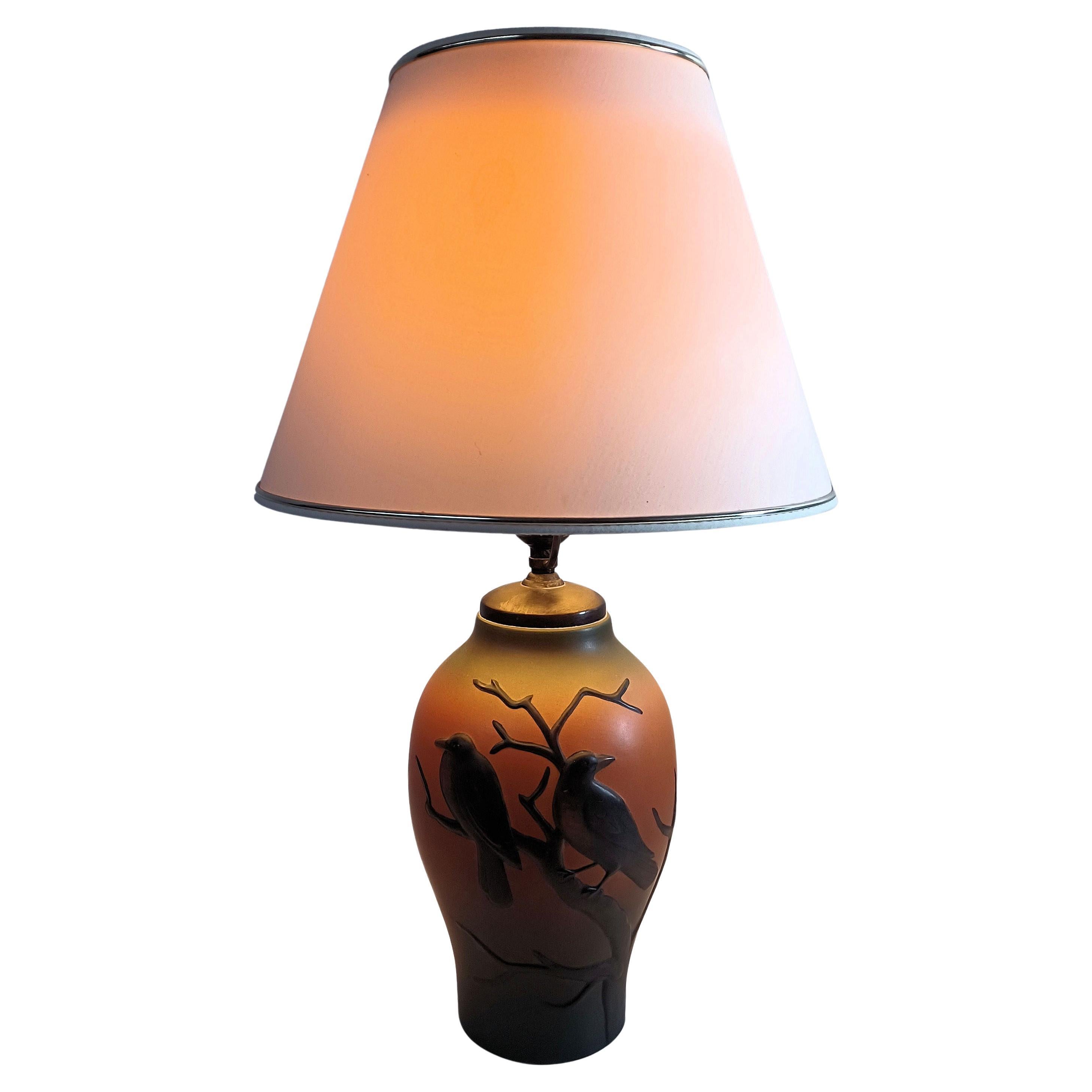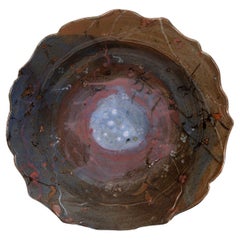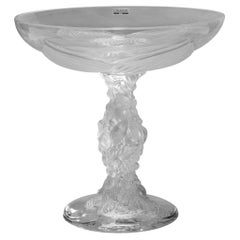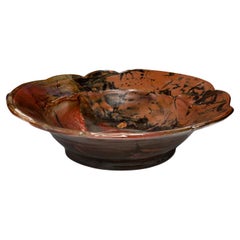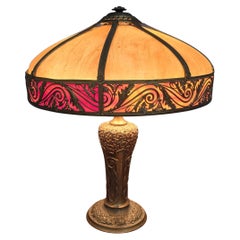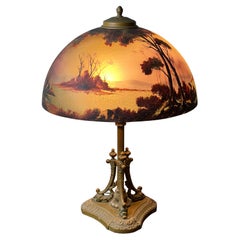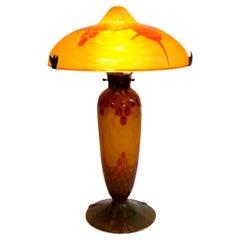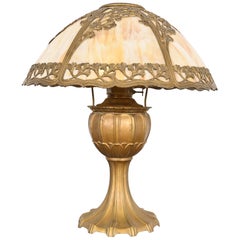Items Similar to Pittsburgh Glass Company Nicolas Kopp Reverse Glass Painting Shade & Lamp
Want more images or videos?
Request additional images or videos from the seller
1 of 21
Pittsburgh Glass Company Nicolas Kopp Reverse Glass Painting Shade & Lamp
$8,500
£6,448.62
€7,393.72
CA$12,108.76
A$13,140.98
CHF 6,914.22
MX$159,663.27
NOK 86,564.74
SEK 81,508.58
DKK 55,205.54
About the Item
SALE ONE WEEK ONLY
"Pittsburgh Glass Company Lamp" Landscape, Reverse Glass Paintng
The landscape painting on the reverse side of the glass shade is an exceptionally fine example of the type of artistry required for this technique. It was very popular during the late 1890s through 1920s. The colors are bright and clear.
Nicholas Kopp founded the original Kopp glass in 1900. Kopp was a renowned chemist, and built the company upon his knowledge and ability to hand mold beautiful lamps and tableware in many colors. In 1901, Kopp took on new partners and renamed the company Pittsburgh Lamp, Brass and Glass Company, again specializing in lamps and lighting in an array of colors and decorations. “Pilabrasgo,” as it was called, produced some of the finest crystal etched and cardinal red satin glass lamps in the world. Kopp developed a Selenium Red Glass that was used in the railroad industry for their signaling lamps. Through the years the company changed ownership and different products. Their reverse painted glass shades were some of their most sought after domestic items.
- Creator:Nicholas Kopp (Designer)
- Dimensions:Height: 24 in (60.96 cm)Diameter: 18 in (45.72 cm)
- Power Source:Plug-in
- Voltage:110-150v
- Lampshade:Included
- Style:Art Nouveau (Of the Period)
- Materials and Techniques:
- Place of Origin:
- Period:
- Date of Manufacture:1890s-1920s
- Condition:Rewired.
- Seller Location:Bloomfield Hills, MI
- Reference Number:1stDibs: LU7781233591172
About the Seller
5.0
Vetted Professional Seller
Every seller passes strict standards for authenticity and reliability
1stDibs seller since 2022
20 sales on 1stDibs
Typical response time: 21 hours
- ShippingRetrieving quote...Shipping from: Detroit, MI
- Return Policy
Authenticity Guarantee
In the unlikely event there’s an issue with an item’s authenticity, contact us within 1 year for a full refund. DetailsMoney-Back Guarantee
If your item is not as described, is damaged in transit, or does not arrive, contact us within 7 days for a full refund. Details24-Hour Cancellation
You have a 24-hour grace period in which to reconsider your purchase, with no questions asked.Vetted Professional Sellers
Our world-class sellers must adhere to strict standards for service and quality, maintaining the integrity of our listings.Price-Match Guarantee
If you find that a seller listed the same item for a lower price elsewhere, we’ll match it.Trusted Global Delivery
Our best-in-class carrier network provides specialized shipping options worldwide, including custom delivery.More From This Seller
View AllJohn Glick Plum Street Pottery Signed Monumental Ceramic Charger
By John Glick
Located in Bloomfield Hills, MI
The ceramic charger with scalloped edge is an example of the kind of work by which John Glick became so famous. He was seduced by the effects of the reduction kiln, which decreased the levels of oxygen during firing, inducing the flame to pull oxygen out of the clay and glazes changing the colors of the glazes depending on their iron and copper content. In this way he achieved the rich gradients of ochre and umber and variations in stippling and opacity. It is signed on verso.
John was an American Abstract Expressionist ceramicist born in Detroit, MI. Though open to artistic experimentation, Glick was most influenced by the styles and aesthetics of Asian pottery—an inspiration that shows in his use of decorative patterns and glaze choices. He has said that he is attracted to simplicity, as well as complexity: my work continually reflects my re-examination that these two poles can coexist… or not, in a given series. Glick also took influences from master potters of Japan, notably Shoji Hamada and Kanjrio Kawai, blending their gestural embellishments of simple forms with attitudes of Abstract Expressionism. He was particularly drown to the work of Helen Frankenthaler whose soak-stain style resonated with Glick’s multi-layered glaze surfaces, which juxtaposed veils of atmospheric color with gestural marks and pattern. He spent countless hours developing and making his own tools in order to achieve previously unseen results in his work with clay and glaze.
Glick’s “Plum Tree Pottery” (now a designated historic landmark in Farmington Hills, Michigan) studio opened around 1965 and closed in the summer of 2016. It was a private studio space for John and a number of his students and assistants. He believed his shapes evolved guided by forces apparently outside his control. This was instinctual, intellectual and due to his openness to change, fusing into what he thought was the most positive force behind a potter’s approach: evolution and growth. Some have called it inspiration.
John was not only a major figure in the Detroit creative community, but in the ceramics world at large. According to Shelley Selim in her book on John, “John Glick: A Legacy in Clay” John remains: “one of the most recognizable names in the field of studio pottery – known for lecturing, publishing, and offering workshops widely – and his work has been featured in well over a hundred local, national and international exhibitions since he was a college student in the late 1950s.” Along with this John has mentored over thirty studio apprentices over five and a half decades, received numerous grants and awards for his work, and has been prolific, with an estimated 300,000 ceramic wares throughout the world.
He received his Masters from Cranbrook Academy of Art in Bloomfield Hills, Michigan, working with Maija Grotell, a legendary and influential teacher. Grotell was noted for her deep interest in the human connection to nature’s rhythms and patters. These ideas often grounded her dialog with her students including Glick, affecting, a profund and lasting influence on his future work. This famous Art Academy was designed by architect and faculty member, Eliel Saarinen who collaborated with Charles and Ray Eames on chair and furniture design. Numerous creative artists who are alumni of Cranbrook include: Harry Bertoia, Florence Knoll, Jack Lenor Larsen, Donald Lipski, Duane Hanson, Nick Cave, Hani Rashid, George Nelson, Urban Jupena (Nationally recognized fiber artist), Artis Lane (the first African-American artist to have her sculpture, "Sojourner Truth," commissioned for the Emancipation Hall in the Capital Visitor Center in Washington DC), Cory Puhlman (televised Pastry Chef extraordinaire), Thom O’Connor (Lithographs), Paul Evans (Brutalist-inspired sculpted metal furnishings), Eugene Caples (small bronze images/abstract), Morris Brose (Bronze Sculptures), Herb Babcock (blown glass), Larry Butcher (mixed media) and Lauren Anais Hussey...
Category
1990s American Expressionist Decorative Dishes and Vide-Poche
Materials
Ceramic
"Abundance" Lalique Crystal
By Lalique
Located in Bloomfield Hills, MI
"Abundance" was produced in Circa 2008. This magnificent design was produced in a limited edition of 99, this being number 47. The foot has the etched trademark signature with the copyright symbol: Lalique France. The piece is both clear and frosted silky crystal with a wide shallow footed bowl molded with a flower on the interior and fruit and foliage molded on the baluster. This is a unique and extraordinary Art Nouveau design. It measures 15.125'' H x 15'' Dia.
René Lalique’s name is synonymous with French Art Nouveau decorative arts. Born in 1860 he first began designing fine jewelry in Paris in 1881, but pursuing increasingly more innovative experimentation in glass commencing around 1883, he eventually created crystal pieces. Early works used the familiar "lost wax" technique by which the model is made in wax while a mold is formed around the model. Then, the wax is melted and molten glass is poured into the mold. Lalique glass was made in this manner until approximately 1905 at which time the factory was redesigned for a larger production.
Without the hand-formed pieces and unique molds, the individual uniqueness of each example of Lalique glass came to an end. The success of this venture resulted in the opening of his own glassworks at Combs-la-Ville in 1909. During the art nouveau period, Lalique was well known for a wide variety of objects including perfume bottles, vases, inkwells, decorative boxes, and bookends.
Lalique glass is lead based, either mold blown or pressed. Characteristically the glass is crystal in combination with acid-etched relief. In addition to vases, clocks, automobile mascots...
Category
Early 2000s French Glass
Materials
Crystal
$42,000
John Glick Plum Street Pottery Ceramic Glazed Bowl/Charger Extra-large
By John Glick
Located in Bloomfield Hills, MI
The ceramic bowl is an example of the kind of work by which John Glick became so famous. He was seduced by the effects of the reduction kiln, which decreased the levels of oxygen during firing, inducing the flame to pull oxygen out of the clay and glazes changing the colors of the glazes depending on their iron and copper content. In this way he achieved the rich gradients of ochre and umber and variations in stippling and opacity. It is signed by the artist and stamped with Plum Street Pottery on the verso.
John was an American Abstract Expressionist ceramicist born in Detroit, MI. Though open to artistic experimentation, Glick was most influenced by the styles and aesthetics of Asian pottery—an inspiration that shows in his use of decorative patterns and glaze choices. He has said that he is attracted to simplicity, as well as complexity: my work continually reflects my re-examination that these two poles can coexist… or not, in a given series. Glick also took influences from master potters of Japan, notably Shoji Hamada and Kanjrio Kawai, blending their gestural embellishments of simple forms with attitudes of Abstract Expressionism. He was particularly drown to the work of Helen Frankenthaler whose soak-stain style resonated with Glick’s multi-layered glaze surfaces, which juxtaposed veils of atmospheric color with gestural marks and pattern. He spent countless hours developing and making his own tools in order to achieve previously unseen results in his work with clay and glaze.
Glick’s “Plum Tree Pottery” (now a designated historic landmark in Farmington Hills, Michigan) studio opened around 1965 and closed in the summer of 2016. It was a private studio space for John and a number of his students and assistants. He believed his shapes evolved guided by forces apparently outside his control. This was instinctual, intellectual and due to his openness to change, fusing into what he thought was the most positive force behind a potter’s approach: evolution and growth. Some have called it inspiration.
John was not only a major figure in the Detroit creative community, but in the ceramics world at large. According to Shelley Selim in her book on John, “John Glick: A Legacy in Clay” John remains: “one of the most recognizable names in the field of studio pottery – known for lecturing, publishing, and offering workshops widely – and his work has been featured in well over a hundred local, national and international exhibitions since he was a college student in the late 1950s.” Along with this John has mentored over thirty studio apprentices over five and a half decades, received numerous grants and awards for his work, and has been prolific, with an estimated 300,000 ceramic wares throughout the world.
He received his Masters from Cranbrook Academy of Art in Bloomfield Hills, Michigan, working with Maija Grotell, a legendary and influential teacher. Grotell was noted for her deep interest in the human connection to nature’s rhythms and patters. These ideas often grounded her dialog with her students including Glick, affecting, a profund and lasting influence on his future work. This famous Art Academy was designed by architect and faculty member, Eliel Saarinen who collaborated with Charles and Ray Eames on chair and furniture design. Numerous creative artists who are alumni of Cranbrook include: Harry Bertoia, Florence Knoll, Jack Lenor Larsen, Donald Lipski, Duane Hanson, Nick Cave, Hani Rashid, George Nelson, Urban Jupena (Nationally recognized fiber artist), Artis Lane (the first African-American artist to have her sculpture, "Sojourner Truth," commissioned for the Emancipation Hall in the Capital Visitor Center in Washington DC), Cory Puhlman (televised Pastry Chef extraordinaire), Thom O’Connor (Lithographs), Paul Evans (Brutalist-inspired sculpted metal furnishings), Eugene Caples (small bronze images/abstract), Morris Brose (Bronze Sculptures), Herb Babcock (blown glass), Larry Butcher (mixed media) and Lauren Anais Hussey...
Category
Late 20th Century American Decorative Dishes and Vide-Poche
Materials
Ceramic
"Goberg Candlesticks" Steel, Iron, Patina, Rare, 1900's, Art Nouveau, Pair
By Goberg
Located in Bloomfield Hills, MI
"Goberg Candlesticks" Steel, Iron, Patina, Rare, 1900's, Art Nouveau, Pair
The exquisite rare antique candlesticks are an ARTS & CRAFT Art Nouveau pair signed GOBERG a Hugo Berger wr...
Category
Antique Early 1900s Austrian Art Nouveau Candlesticks
Materials
Metal, Steel, Iron
John Glick Plum Street Pottery Ceramic Charger Monumental
By John Glick
Located in Bloomfield Hills, MI
The ceramic charger is an example of the kind of work by which John Glick became so famous. He was seduced by the effects of the reduction kiln, which decreased the levels of oxygen during firing, inducing the flame to pull oxygen out of the clay and glazes changing the colors of the glazes depending on their iron and copper content. In this way he achieved the rich gradients of ochre and umber and variations in stippling and opacity. It is signed by the artist and stamped with Plum Street Pottery #129 on the verso.
John was an American Abstract Expressionist ceramicist born in Detroit, MI. Though open to artistic experimentation, Glick was most influenced by the styles and aesthetics of Asian pottery—an inspiration that shows in his use of decorative patterns and glaze choices. He has said that he is attracted to simplicity, as well as complexity: my work continually reflects my re-examination that these two poles can coexist… or not, in a given series. Glick also took influences from master potters of Japan, notably Shoji Hamada and Kanjrio Kawai, blending their gestural embellishments of simple forms with attitudes of Abstract Expressionism. He was particularly drown to the work of Helen Frankenthaler whose soak-stain style resonated with Glick’s multi-layered glaze surfaces, which juxtaposed veils of atmospheric color with gestural marks and pattern. He spent countless hours developing and making his own tools in order to achieve previously unseen results in his work with clay and glaze.
Glick’s “Plum Tree Pottery” (now a designated historic landmark in Farmington Hills, Michigan) studio opened around 1965 and closed in the summer of 2016. It was a private studio space for John and a number of his students and assistants. He believed his shapes evolved guided by forces apparently outside his control. This was instinctual, intellectual and due to his openness to change, fusing into what he thought was the most positive force behind a potter’s approach: evolution and growth. Some have called it inspiration.
John was not only a major figure in the Detroit creative community, but in the ceramics world at large. According to Shelley Selim in her book on John, “John Glick: A Legacy in Clay” John remains: “one of the most recognizable names in the field of studio pottery – known for lecturing, publishing, and offering workshops widely – and his work has been featured in well over a hundred local, national and international exhibitions since he was a college student in the late 1950s.” Along with this John has mentored over thirty studio apprentices over five and a half decades, received numerous grants and awards for his work, and has been prolific, with an estimated 300,000 ceramic wares throughout the world.
He received his Masters from Cranbrook Academy of Art in Bloomfield Hills, Michigan, working with Maija Grotell, a legendary and influential teacher. Grotell was noted for her deep interest in the human connection to nature’s rhythms and patters. These ideas often grounded her dialog with her students including Glick, affecting, a profund and lasting influence on his future work. This famous Art Academy was designed by architect and faculty member, Eliel Saarinen who collaborated with Charles and Ray Eames on chair and furniture design. Numerous creative artists who are alumni of Cranbrook include: Harry Bertoia, Florence Knoll, Jack Lenor Larsen, Donald Lipski, Duane Hanson, Nick Cave, Hani Rashid, George Nelson, Urban Jupena (Nationally recognized fiber artist), Artis Lane (the first African-American artist to have her sculpture, "Sojourner Truth," commissioned for the Emancipation Hall in the Capital Visitor Center in Washington DC), Cory Puhlman (televised Pastry Chef extraordinaire), Thom O’Connor (Lithographs), Paul Evans (Brutalist-inspired sculpted metal furnishings), Eugene Caples (small bronze images/abstract), Morris Brose (Bronze Sculptures), Herb Babcock (blown glass), Larry Butcher (mixed media) and Lauren Anais Hussey...
Category
1990s American Expressionist Decorative Dishes and Vide-Poche
Materials
Ceramic
John Glick Plum Street Pottery Ceramic Charger Monumental
By John Glick
Located in Bloomfield Hills, MI
The ceramic charger is an example of the kind of work by which John Glick became so famous. He was seduced by the effects of the reduction kiln, which decreased the levels of oxygen during firing, inducing the flame to pull oxygen out of the clay and glazes changing the colors of the glazes depending on their iron and copper content. In this way he achieved the rich gradients of ochre and umber and variations in stippling and opacity. It is signed by the artist and stamped with Plum Street Pottery on the verso.
John was an American Abstract Expressionist ceramicist born in Detroit, MI. Though open to artistic experimentation, Glick was most influenced by the styles and aesthetics of Asian pottery—an inspiration that shows in his use of decorative patterns and glaze choices. He has said that he is attracted to simplicity, as well as complexity: my work continually reflects my re-examination that these two poles can coexist… or not, in a given series. Glick also took influences from master potters of Japan, notably Shoji Hamada and Kanjrio Kawai, blending their gestural embellishments of simple forms with attitudes of Abstract Expressionism. He was particularly drown to the work of Helen Frankenthaler whose soak-stain style resonated with Glick’s multi-layered glaze surfaces, which juxtaposed veils of atmospheric color with gestural marks and pattern. He spent countless hours developing and making his own tools in order to achieve previously unseen results in his work with clay and glaze.
Glick’s “Plum Tree Pottery” (now a designated historic landmark in Farmington Hills, Michigan) studio opened around 1965 and closed in the summer of 2016. It was a private studio space for John and a number of his students and assistants. He believed his shapes evolved guided by forces apparently outside his control. This was instinctual, intellectual and due to his openness to change, fusing into what he thought was the most positive force behind a potter’s approach: evolution and growth. Some have called it inspiration.
John was not only a major figure in the Detroit creative community, but in the ceramics world at large. According to Shelley Selim in her book on John, “John Glick: A Legacy in Clay” John remains: “one of the most recognizable names in the field of studio pottery – known for lecturing, publishing, and offering workshops widely – and his work has been featured in well over a hundred local, national and international exhibitions since he was a college student in the late 1950s.” Along with this John has mentored over thirty studio apprentices over five and a half decades, received numerous grants and awards for his work, and has been prolific, with an estimated 300,000 ceramic wares throughout the world.
He received his Masters from Cranbrook Academy of Art in Bloomfield Hills, Michigan, working with Maija Grotell, a legendary and influential teacher. Grotell was noted for her deep interest in the human connection to nature’s rhythms and patters. These ideas often grounded her dialog with her students including Glick, affecting, a profund and lasting influence on his future work. This famous Art Academy was designed by architect and faculty member, Eliel Saarinen who collaborated with Charles and Ray Eames on chair and furniture design. Numerous creative artists who are alumni of Cranbrook include: Harry Bertoia, Florence Knoll, Jack Lenor Larsen, Donald Lipski, Duane Hanson, Nick Cave, Hani Rashid, George Nelson, Urban Jupena (Nationally recognized fiber artist), Artis Lane (the first African-American artist to have her sculpture, "Sojourner Truth," commissioned for the Emancipation Hall in the Capital Visitor Center in Washington DC), Cory Puhlman (televised Pastry Chef extraordinaire), Thom O’Connor (Lithographs), Paul Evans (Brutalist-inspired sculpted metal furnishings), Eugene Caples (small bronze images/abstract), Morris Brose (Bronze Sculptures), Herb Babcock (blown glass), Larry Butcher (mixed media) and Lauren Anais Hussey...
Category
1990s American Expressionist Decorative Dishes and Vide-Poche
Materials
Ceramic
You May Also Like
Superb Art Noveau Lamp by The Charles Parker Company
By Charles Parker
Located in Swadlincote, GB
A wonderful slag glass Art Noveau table lamp by American company 'Charles Parker Company', double bulb, ready to use condition having been pat tested.
24" high
20" diametr
7.5" dia...
Category
Early 20th Century Central American Art Nouveau Table Lamps
Materials
Slag Glass
Antique Phoenix School Arts and Crafts Reverse Painted Lamp c. 1920
By Pittsburgh Lamp, Brass and Glass Company
Located in Westfield, MA
This stunning Antique Phoenix School Arts and Crafts Reverse Painted Lamp by Pittsburgh, c. 1920, features a beautifully painted shade that demonstrates the innovative techniques of ...
Category
Vintage 1920s American Arts and Crafts Table Lamps
Materials
Brass
Le Verre Francais Cameo Glass Lamp
By Schneider
Located in Autonomous City Buenos Aires, CABA
A wonderful early 20th century Art Deco glass lamp etched motifs against a orange background with excellent color and detail. The light fitting made of hammered wrought iron, rewired...
Category
Early 20th Century French Art Deco Table Lamps
Materials
Art Glass
Antique Art Nouveau Slag Glass Table Lamp by Miller Lamp Co., Circa 1920s
By Miller Lamp Company
Located in South Bend, IN
An exceptional antique Art Nouveau period table lamp with gorgeous six-panel caramel curved slag glass shade
By Miller Lamp Company
USA, Circa 1920s
Measures: 19.25"W x 19.25"D x ...
Category
Vintage 1920s American Art Nouveau Table Lamps
Materials
Metal
Art Nouveau Slag Glass Table Lamp with Metal Overlay
Located in San Francisco, CA
American slag glass table lamp in the Art Nouveau style, likely from the 1910s to 1920s. Features a paneled shade in green, amber, and cream glass with decorative metal overlay, and ...
Category
Vintage 1920s American Modern Table Lamps
Materials
Metal
1920s Art Nouveau Hand-crafted Table Lamp by Georg Thylstrup for P. Ipsens Enke
By P. Ipsens Enke, Georg Thylstrup
Located in Knebel, DK
1920sArt Nouveau hand-crafted table lamp by Georg Thylstrup for P. Ipsens Enke
The hand-crafted art nouveau table lamp was designed by eorg Thylstrup in 1927 and feature two craws ...
Category
Mid-20th Century Danish Art Nouveau Table Lamps
Materials
Ceramic
More Ways To Browse
Antique Glass Companies
Antique Glass Painting
Antique Reverse Painted
Reverse Glass Painting
Reverse Glass Art
Red Cardinal
Painting Antique Dining Room Furniture
Antique Red Glass Lamps
Antique Pittsburgh Glass
1920s Reverse Painted Table Lamps
Antique Pittsburgh Lamps
Pittsburgh Lamp
Lamps Pittsburgh Glass
Antique Reverse Painted Art Nouveau Lamps
Reverse Painting Lamp
Vintage Lampshade Frames
Vintage Lucite Rings
Vintage Swing Arm Desk Lamp Lamps
